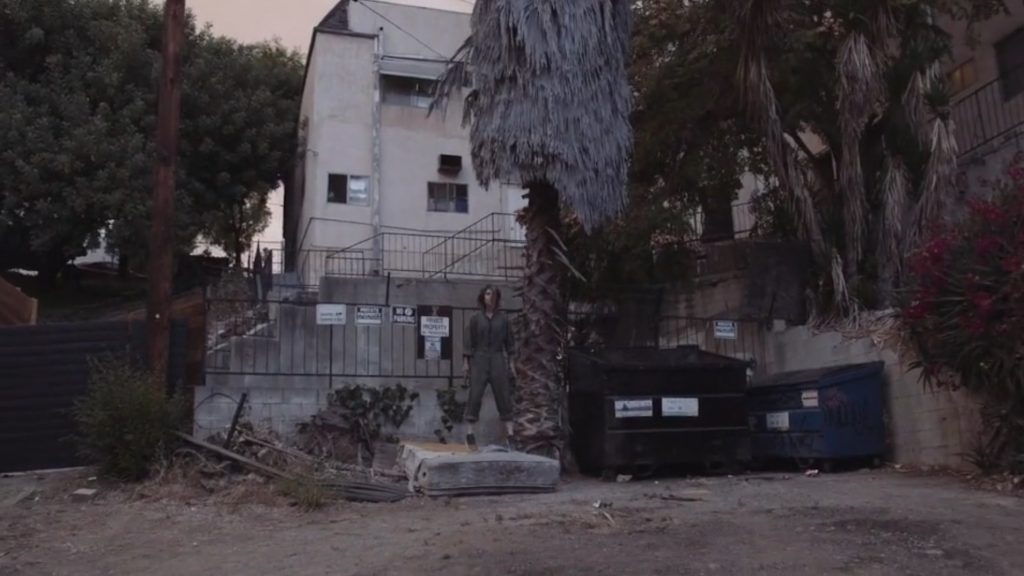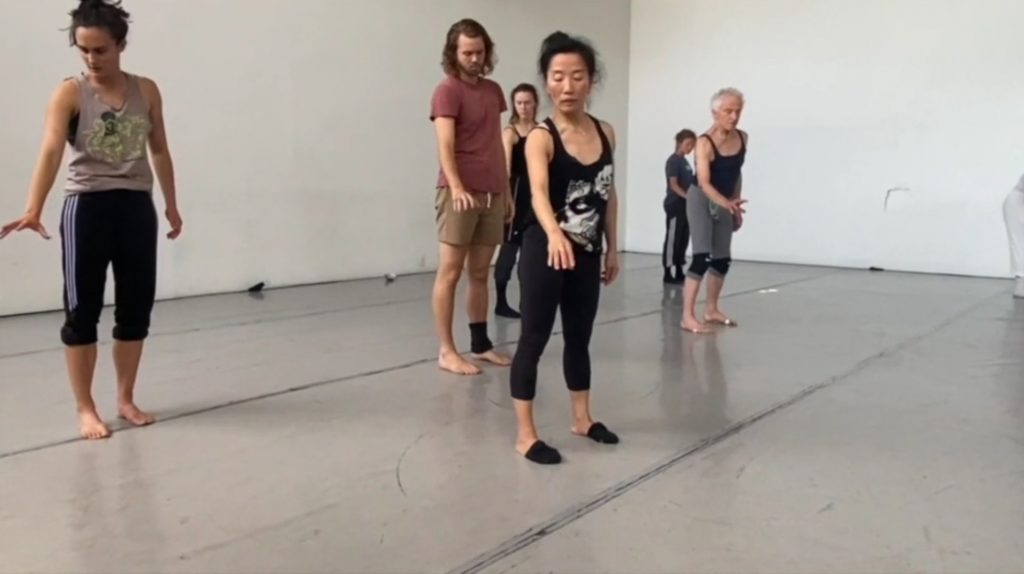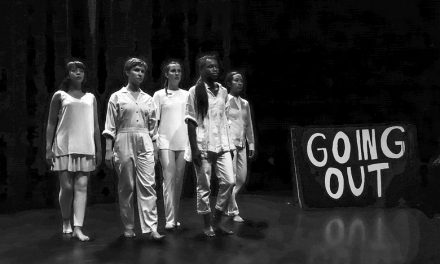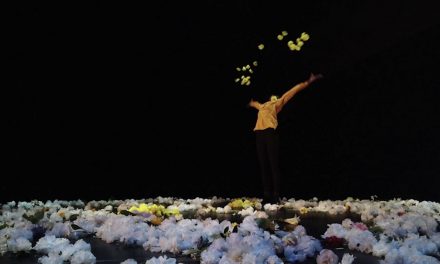On June 4th Deborah Brockus and SHIFT/west residency – Women Choreographers launched their online showcase running from June 4 through June 10th on Vimeo. Twelve works were produced and mentored by Brockus with funding support from a grant by the California Arts Council empowering L.A.’s female choreographers at various stages of their creative journey by supporting their voices and vision. It is a wonderful evening of fun, artistry and creative invention. Tickets are $15 per household, HERE.
The first piece, a product of the Brockus SHIFT/west residency for Women Choreographers began with a unique filmic morsel by Rourou Ye, called “Daydreaming.” At first the incongruous perspective of legs dangling from the ceiling of a cream colored room, with the character struggling, perhaps hanging, perhaps crawling down the wall to a door that seemed to be the only way out. Even though there appeared to be a way to the outside world, the traps were many, with a ghostly alter ego challenging our main character both daring and chiding her and sometimes soothing the trapped disoriented Ye. Eventually, both Ego and Alter Ego, in a fascinating duet, opens the door and leads to steps to nowhere. The ticking of a clock and almost nursery rhyme music by the talented, Sophia Shen, is playful and childlike. It delights us with its dreamscape of light and tones. Ye’s “Daydreaming” creates a series of surreal moments, and an imaginative rendering of what appears to be the deadly fires of 2020. Then it ends with curious roguery by making a pithy point to end of the piece. The filmmaking and movement is a fascinating and fun work which reflects the metaphor of the curious and unnerving months of the last year. A remarkable and interesting work.
Helen Duros’ Between Oak and Magenta was done to just groove among trees. Did she find her groove???? The intersection between birds, trees, and Duros’ lovely face and body, grooving on a spring afternoon…was just fun to watch and enjoy. But groove? Setting in the pocket of the music? Maybe it requires going back to the great groove masters, since it’s all about the music, and this was more about the image.
On the other hand, Malia Baker’s Fight Back, Choreographer/performer fighting the Dancer in the Mirror finally finds the joy, soul and a freedom in her own self. It is beautifully shot by Director and Editor Riley Roberts – and lit by Lighting designer/gaffer, Camille Roberts, and Rin Mizumoto. Baker’s relationship to the camera, the mirror and the image in the mirror with the fabulous upbeat music “Fight Back” by Pomplamoose would make anyone want to get up and move beyond their body. Baker’s joy and use of the wonderful space and rhythms is such fun and yes even gives us chills. And one can’t help but chuckle at the Production Assistant’s credit a “General Bad Ass.” Well done to all!
Hannah Millar’s piece What’s Your Choice [It’s Beautiful Over Here] explores the choice between being closed off from contentment and peace in our lives. The use of sacks over the heads of the performers Julia Gonzalez, Keilan Stafford, Catalina Eddy, Bailey Holladay and Halie Donabedian is reminiscent of the imprisonment and torture some 20 years ago. The soft whisperings of names, trying to get the attention of the covered headed subjects as they signed and aligned while rolling over each other’s bodies. Needless to say, it did create a kind of mystery, and the music felt Requiem-esque by Steven Schwartz. Then we’re led to a sudden pan of the camera to fields of purple flowers and Gonzalez in a white shift…trying to get her masked friend’s attention, soul to soul, somehow. “It’s so beautiful here” she whispers. It definitely created wonderment in the audience viewing the piece, but the symbolism and depth was left on the paper in the stage notes. Unfortunately, not quite making it into the piece.
This is a Crystalin mystical afro-centric piece –Continuum Presented Ase/Ibalik, with Director/Choreographer- Alyssa Junious. The words and the movements were powerful and clear…and if not enough, the words declared the message. “Now is the time to overturn the paradigm inflicted upon our people.” With undulating arms, legs and bodies bathed in multi colors with backdrops of purple blue light they declared, “We need no commission to celebrate our blackness.” The message was about “the intersection of spirituality and activism and taps into the spiritual power of dance.” (Junious) The dancers, Irishia Hubbard, Danielle Matthew, and Alyssa Junious were beautiful, focused and well-rehearsed. They were clear, the piece and message were clear, and both speaker and dancers were pointed in their execution of the piece. The music was from Native Tribe & TTan – Ancestors Calling (Enoo Napa Rituals Mix). The line, “It’s our ancestors calling” was a reminder of the words and wisdom of the past.The young women wore black leotards and tops – strings of jewels and beads around waist, necks and ears. Their long tresses, flying and swaying with their bodies. Revolution was clearly the message; this piece was unrelenting in its honesty. The message unreasonable, their voices must be heard…as spoken by the Lead woman…the spokeswoman, the poetess. With pulsating drums, and rhythms. She speaks:
“ Heard through the language of dance, nature, spirit and frequency, Vibratory communication via divine light. …
“Delivers our emancipation, our divine right. The elders…Their words demand our attention; their teaching demands our
“…We offer prayers of gratitude. We listen and we honor these.
“We need no permission to celebrate our blackness…With no prior warning, it’s our ancestors calling. With every strike of the drum, the threesome in powerful coordination on the purple-pink cyc with a mission and laser focus.
“Every strike of the drum we wave our fists to the sun!” Double exposure of faces, hands and arms created a feeling that this was no long one voice but many as one. A powerful un-self-conscious and respectful declarative revolutionary piece.
Brittany Delany, dancer choreographer, co-directed with Letxia Cordova the Cinematographer dipped into an exploration of a “Dance Horror Film titled Stalk. The fear factor was quite good, however the characters and who they were to each other, why the attacker wanted to attack the victim and who the shrouded woman was and why she was there, needed to be flushed out. The original music by Jordan Lewis held up and was a true assist for this video. However, greater exploration needs to be done for this story to be coherent to the audience.
“Forget the Flowers” Written, created, choreographed and produced by Toni Fuller, starring Toni Fuller and Justin Wolfe with original music by Steven M. Schwartz. Dancers are Aymara De Llano, Alyssa Milligan, and Kistina Pressler. The piece explores the end of a relationship, the rejection, the hope of reconciliation, the begging, reaching, withdrawing, remembering, and most difficult of all, the moments of love and ecstasy. There are some tools Fuller uses to make her piece work. The back flashes that took us all back to better days. However, it was unclear why in the beginning the relationship took a turn. It then was also unclear why she took to begging him repeatedly which then took the audience to fear for her life the violence seemed gratuitous. It would also have been important to explore her relationship with her friends, so that when they are there for her, there was some feeling between them. Right now, they just appear to be just props for her. Without these considerations, we are not involved enough with her to care. This is the time to explore…and see what can be culled out.
Boxed is a dance number…in a triangle with three dancers Jasmine Alexandria, Jade James and Keilan Staff. No changes occur in this piece, even though Letxia Cordova the choreographer/filmmaker proposes in the lofty performance notes to explore the piece’s depiction of the rising rebellion against the corporate world and traditional family structure, nothing of the sort occurs. The costuming is street wear – “All I need is 5 minutes” is the mantra that is repeated throughout the piece. The primary elementary choreography does not touch the stated theme. Only once toward the end does anything change from unison, with dancers stuck to the floor and never moving outside their assigned point. The only time it differs for a second is when the dancers suddenly break and execute a second of individual improv, yet never leaving their spot on the floor, never using the space and never really set free. This is for just a moment and then they are back stuck in place.
Perhaps what’s needed is more examination and back to the drawing board to deal with the theme and the choreographic structure.
Corrine Kinnear’s “Work in Progress” at first follows different dancers of all body shapes, ethnicities and ages as they internally find their own rhythm, over the sustained chords played meditatively against their movements. They explore levels from rolling and standing…bodies together and apart. Some movements take on a Tai Chi quality. A lovely and interesting combination and culmination of groups, pairs, a brief pas de deux, into solos, all exploring movement and energy through space and periods of time to end with a circle slowly duplicating the movements of nearby dancers. Certainly, for the dancers and choreographer this is a joyous exploration that obviously is the nascent beginnings of …”something,” or it is a class to explore the dancers soul. It could be anything and most definitely a work in progress.
Byou1 Part 2: Da is a beautiful film by Taso Papadakis with the noted DaEun Jung, dancer/choreographer dubbed a “Cultural Trailblazer” by the City of Los Angeles Department of Cultural Affairs for 2019-2020. DaEun seeks “innovative compositional methods to craft classical or gestural movements.” Using Korean Dance, she explores and studies patterns, numbers, algorithms along with children’s games to inspire her work and “pleasure of life.” She has exquisitely paired with the vocalist Melody H. Sim (Shim) who provides an elegant vocal structure. In her solo vocal libretto Sim coordinates sustained vocal notes with short, clipped sounds to support Da’s lovely, elongated movements and sudden gentle changes. Reach and relax, they breathe together, movement to sound, melding love for space and movement with the camera, which whirls around Da. The expert camera work explores the 360 degree space of the wooded studio, then resting on the classic face of DaEun who moves into her final pose with lovely extended arms reaching out beyond her diminutive body. We soon realize that this is something to watch over again for the purpose of catching the subtleties and nuances that come with artistry. This piece is one of the highlights of the evening.
Strelitzia is a colorful and outrageous piece that treats the audience to a Cirque-like reveal geared to tickle the senses. This ambitious frolic is named after five species of native South African perennial plants named after Queen Charlotte of the U.K., otherwise known as the “Bird of Paradise.” The choreographers, Charlotte Smith and Dora Novak, in collaboration with dancers Moi Michel, Amanda MacLeod, Lorenzo Edwards, have used movement fashioned after birds or animals. The unique work of cinematographer, Benjamin Tedesco manages to angle and shoot unorthodox views of the performers. The outrageous Costume Design and Construction by Dora Novak and Assistant Cody Brunelle Potter, leads to brilliant multicolored ruffles, medieval costume touches, sparkles and netting that almost challenge Technicolor films of the past with the help of Video Colorist, Jose A. Hernandez Jr.
At the start of the piece the camera pans up past the parched earth and resting nude bodies. Then without warning the location changes to a lakeside marked with leafless trees hiding from view parts of the dancers lithe bodies. The use of chairs, sofas and makeshift construction are resting places for the languorous and very human Birds of Paradise. A young woman in red toile, blue eye shadowed men, soon the costumes begin to get more creative and outrageous. White soundscapes, ruffles, animal-like movements and preening bodies in highly hued plumage covers the dancers faces as they work. It’s this disorder, spangles, netting that puts color on the parched earth. The white soundscape becomes a chanting that instigates the birdlike creatures to fall in line and fade into the night. This is not dance per se, but takes dancers to do the movement, yet it is a feast for the eyes.
Seeing these works of The Brockus Projects’ shift to the use of film in movement during the Pandemic has created another medium of expression for dance locally, which I believe has spurred important expansion and unique invention. The variety and experimentation on a “shoestring” has proven a powerful new tool for the female dancer/choreographers and their crews. Brockus has fought to make this possible. I congratulate her and SHIFT/west residency participants and thank them all for surviving, thriving and creating some wonderfully inventive and exciting work.
To view SHIFT/west residency – Women Choreographers ($15 per household), click HERE.
To visit Brockus Project Dance, click HERE.
Written by Joanne DiVito for LA Dance Chronicle.
Featured image: DaEun Jung in “Byou1 Part 2: Da” – Screenshot by LADC

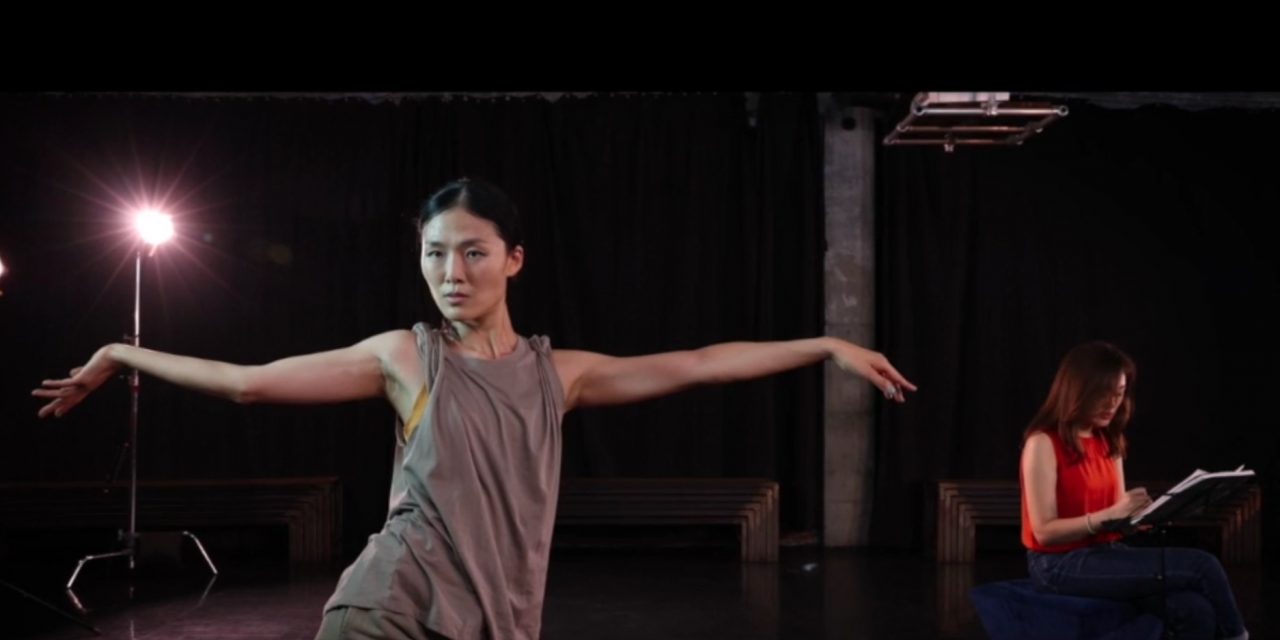



![Hannah Millar - "What’s Your Choice [It’s Beautiful Over Here]" - Screenshot by LADC](https://www.ladancechronicle.com/wp-content/uploads/2021/06/Dance-4-1024x579.jpg)

